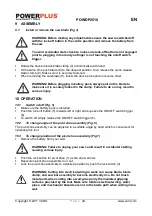
POWDP2510
EN
Copyright © 2017 VARO
P a g e
|
6
www.varo.com
Before switching on the tool, be sure the blade in not contacting the work piece.
Keep hands away from moving parts and on the top surface of the work piece. Do not
place hands below work surface while saw is operating.
Hold tool by insulated grip surface when performing an operation where the cutting tool
may contact the hidden wiring or its own cord. Contact the alive wire make exposed the
metal parts of the tool alive and shock the operator.
Do not stare at the tool with the blade touching any surface. The blade action will bounce
the tool and may cause bodily injury.
Always wear safety glasses or goggles, normal prescription eye or sunglasses are not
safety glasses
Check your area for proper clearance before cutting. This will avoid cutting into your
workbench, the floor, etc.
This product is not a toy. Keep it out of reach of children.
People with pacemakers should consult their physician(s) before use. Electromagnetic
fields in close proximity to heart pacemaker could cause pacemaker interference or
pacemaker failure. In addition, people with pacemakers should:
Avoid operating alone.
Do not use with power switch locked on.
Properly maintain and inspect to avoid electrical shock.
7 ADDITIONAL SAFETY INSTRUCTIONS FOR BATTERIES AND
CHARGERS
7.1
Batteries
Never attempt to open for any reason.
Do not store in locations where the temperature may exceed 40 °C.
Charge only at ambient temperatures between 4 °C and 40 °C.
When disposing of batteries, follow the instructions given in the section “Protecting the
environment”.
Do not cause short circuits. If connection is made between the positive (+) and negative (-)
terminal directly or via accidental contact with metallic objects, the battery is short circuited
and an intense current will flow causing heat generation which may lead to casing rupture
or fire.
Do not heat. If batteries are heated to above 100 °C, sealing and insulating separators
and other polymer components may be damaged resulting in electrolyte leakage and/or
internal short circuiting leading to heat generation causing rupture or file. Moreover do not
dispose of the batteries in fire, explosion and/or intense burning may result.
Under extreme conditions, battery leakage may occur. When you notice liquid on the
battery, proceed as follows:
Carefully wipe the liquid off using a cloth. Avoid skin contact.
In case of skin or eye contact, follow the instructions below:
Immediately rinse with water. Neutralize with a mild acid such as lemon juice or
vinegar.
In case of eye contact, rinse abundantly with clean water for at least 10 minutes.
Consult a physician.
Fire hazard! Avoid short-circuiting the contacts of a detached battery. Do
not incinerate the battery.
7.2
Chargers
Never attempt to charge non-rechargeable batteries.
Have defective cords replaced immediately.






























